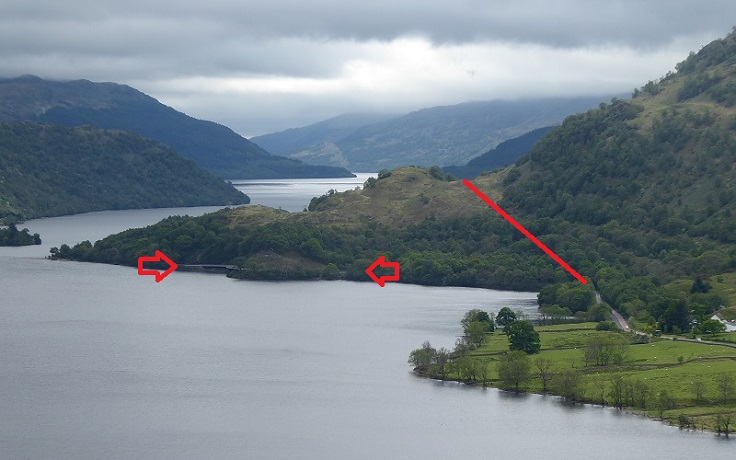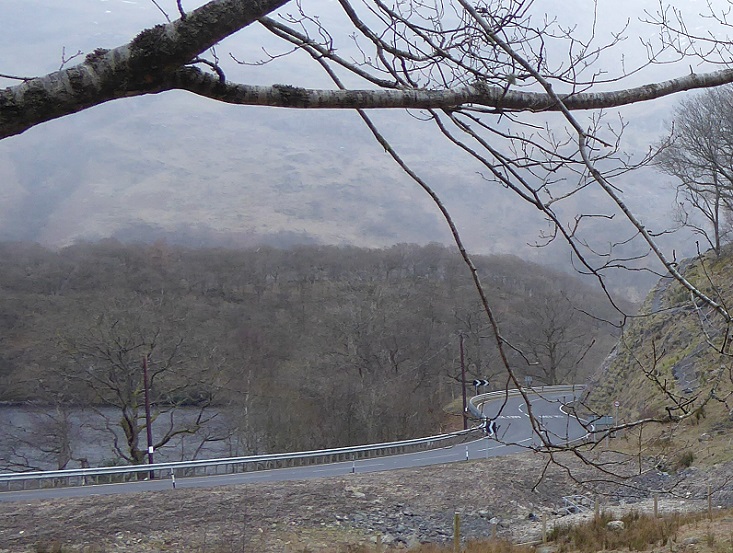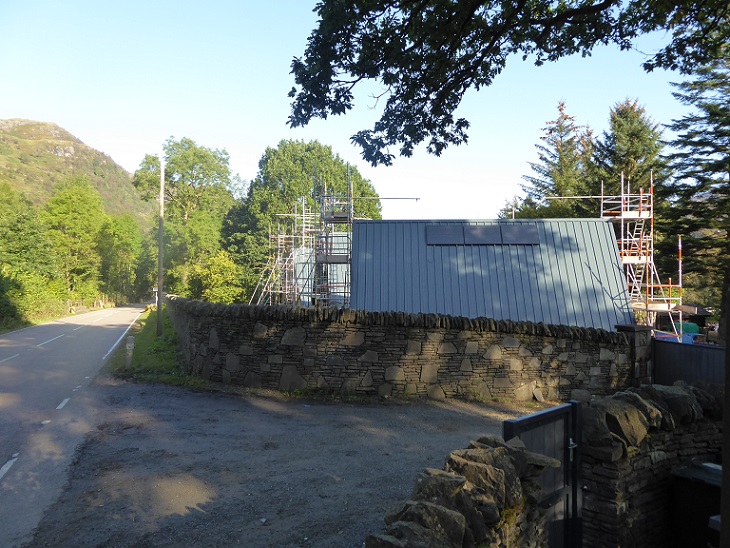
[Editor’s note: this article follows John Urquhart’s proposal for an alternative high level route above Loch Lomond (see here) and my follow-up post on the discussion of the A82 upgrade at the December LLTNPA meeting (see here)].
If Loch Lomond Park and Trossachs National Park Authority (LLTNPA) had been given £400m to spend on transport infrastructure right in the middle of the National Park, it is unlikely to have spent it on widening and straightening the main road, an action that would both wreck the oak woodlands (in a Site of Special Scientific Interest), increase the noise over the whole of the north of the loch and increase traffic problems in Tarbet and Ardlui. And yet they appear to be willing to go ahead with such a proposal from TransportScotland. How has this happened?
At first sight it looks like a failure in the infrastructure planning system as defined in the Scottish Strategic Transport Assessment Guidance (STAG). STAG provides a methodology to look at and compare different methods (or routes) to achieve stated objectives. It should have been applied to alternative routes for the A82 and should have looked, in detail, at both the shoreside and a high-level route above and to the west of the railway. Despite what appears to be a legal requirement, in fact no such appraisal was undertaken.
STAG is essentially pro-active asking the question “what is the best way of …”. LLTNPA Planning, however is essentially re-active; “if Transport Scotland are planning to do this how can we best use it to achieve our objectives of a cycle path and more lochside parking and minimise the environmental cost”. By engaging with Transport Scotland they have become embarrassingly conscripted to the outcome without securing any actual commitment to building an adequate cycle path, providing parking or dealing with heavy flows of traffic through Tarbet and Ardlui.

The result of this type of approach can best be seen at Pulpit Rock. For many years there was a traffic-controlled section around the rock because of very limited width. As part of the A82 widening scheme, a viaduct was built over the loch that produced a 30mph bend, no cycle track and no additional parking. Originally estimated at £4.5m it more than doubled in cost to £9.2m and will cost millions more if Transport Scotland live up to their commitment to have a cycleway along the whole of the A82.
In fact an alternative of a tunnel (see above) was assessed and dismissed as “too expensive”. Sounds very familiar! It now appears it would have been cheaper, provided the cycle path and parking, and straight (no 30mph bend for heavy lorries to negotiate).
Why has STAG not been applied to Pulpit Rock and the current proposals? They started from an initial perception that they was simply part of a road improvement scheme involving widening and straightening the whole of the A82 from Fort William to Glasgow. The reasoning was as follows
“Early discussions with Transport Scotland have concluded that previous preliminary assessment work undertaken to support the STPR identification of potential interventions for the A82 was consistent with STAG appraisal requirements and there is no need, therefore, to undertake a further full STAG appraisal for the Tarbet to Inverarnan section of the A82.”
Put simply it was clear that there was really no sensible alternative to improving the A82 so there was no need to undertake full appraisals, rather the planning work should follow the Design Manual for Roads and Bridges (DMRB). It will be argued (by officials?) in response that the DMRB Part 1 Assessment, used instead of STAG, did consider public needs. Specifically, the objectives were clearly stated as:
- to improve average journey times for A82 trunk road users between Tarbet and Inverarnan (based on observed post Pulpit Rock scheme);
- to reduce personal injury accident numbers and their severity on the A82 between Tarbet and Inverarnan to be closer to or better than national KSI [“killed or seriously injured”] rates;
- to increase formal parking capacity between Tarbet and Inverarnan through appropriate opportunities that take account of the unique setting of the route within the National Park;
- to seek to provide opportunities to integrate with Loch Lomond and Trossachs National Park Authority (LLTNPA) objectives for the provision of enhanced/new Non Motorised User (NMU) infrastructure and facilities; and
- to reduce disruption to road users resulting from the undertaking of maintenance activities on the A82 between Tarbet and Inverarnan.
The Part 1 assessment that compared shoreside and high routes found the “high route” was likely to
- Be quicker
- Be safer
- Produce more parking areas on the shoreside along the old road
- Be far less difficult to provide active travel facilities along the old road
- Lead to far less disruption to vehicle movement during both construction and subsequent maintenance.
Given these are indisputable, the question is raised as to how the assessment concluded that the shoreside route was preferable. As might be expected this involved “Cost”. A STAG appraisal requires a fully documented assessment of cost for all options. This would require as a minimum specification of, for example, the viaducts and tunnels required given the topography. In the DMRB assessment
“The cost estimates are not based on accurate topographic, geotechnical or environmental data and as such these estimates may have a high degree of variability”.
Because there appears to be no detailed specification of the infrastructure requirements of either route, the cost estimates in the assessment seem to be little more than guesswork, with the justification for any subsequent error in the note quoted above. They are also completely out of date given ministerial commitments to cycle-path design.

As a consequence, the supposed difference in costs is totally unreliable. Can it be argued that when all the objectives are best satisfied by the high-level route, to choose the shore-side route on the basis of a guess is acceptable? This actually suggests a strong preconception of the “right” solution and a willingness to cut corners to press on with it. This would not have occurred if the full STAG appraisal had been properly completed.
The Park Authority has never considered how this huge investment in the infrastructure of the Park could best meet its objectives. Instead, it has simply reacted to proposals put to it. It has never considered whether the estimates submitted in assessments are reasonable, which the evidence of Pulpit Rock suggests they are not. It is still not too late for it to insist upon a full STAG Appraisal and to publish clear plans for what they might be able to do if the old road was clear of through traffic.

If the proposal is not reversed it is essential that the Park Authority tie down Transport Scotland to build a cycleway to minimum design standards (2.5m verge, 2.5m path), to explain where the cyclepath will go in Tarbet, Ardlui and at Pulpit Rock, to make clear that a 40mph speed limit through the middle of Ardlui does nothing to promote use of rail, walking or cycling. It should require a commitment to establish car parks, to replant any woodland and to fully include cost estimates of these “additional requirements”. Finally the resulting implication for the Nation Park for both High and Shoreside Routes should be a clear part of the Park Plan.
[Note about the Author. Dr Geoff Riddington is a retired academic – an economist and former Reader in Transport Appraisal at Glasgow Caledonian University and an expert in cost benefit analysis. He was a co-author of a report for LLTNPA entitled “Valuing the National Park” which is available at Researchgate (see here) but not on the research section of the LLTNPA website!. He is currently a Board Member of the Helensburgh and District Access Trust (HADAT)].
3 Comments on “Pro-Active and Re-Active Planning: The Case of the A82 Tarbet to Inverarnan”